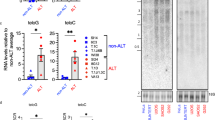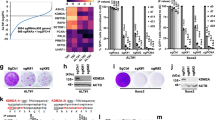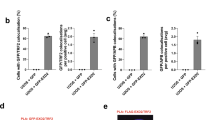Abstract
Abrogation of telomere stability through loss-of-function mutations in telomere binding proteins contributes to genomic instability and cancer progression. Recently, Flap endonuclease 1 (FEN1) was shown to contribute to telomere stability in human cells that had not yet activated a telomere maintenance mechanism, suggesting that abrogation of FEN1 function influences the transformation process by compromising telomere stability and driving genomic instability. Here, we analyse the telomeres in human cancer cells following FEN1 depletion. We show that FEN1 is required for telomere stability in cells that rely on the alternative lengthening of telomere (ALT) mechanism. Indeed, FEN1 depletion resulted in telomere dysfunction, characterized by formation of telomere dysfunction-induced foci (TIFs) and end-to-end fusions in ALT-positive cells. In contrast, no telomere phenotype was observed in telomerase-positive cells on FEN1 depletion, suggesting that ongoing telomerase activity protected telomeres. In consonance with this, we found that expression of the catalytic component of telomerase (hTERT) but not an inactive allele rescued telomere dysfunction on FEN1 depletion in ALT cells. Our data suggest that mutations that arise in FEN1 affect telomere stability and genome fidelity by promoting telomere fusions and anaphase–bridge–breakage cycles, which further drive genome instability and thereby contribute to the transformation process.
This is a preview of subscription content, access via your institution
Access options
Subscribe to this journal
Receive 50 print issues and online access
$259.00 per year
only $5.18 per issue
Buy this article
- Purchase on Springer Link
- Instant access to full article PDF
Prices may be subject to local taxes which are calculated during checkout



Similar content being viewed by others
References
Artandi SE, DePinho RA . (2000). A critical role for telomeres in suppressing and facilitating carcinogenesis. Curr Opin Genet Dev 10: 39–46.
Blasco MA . (2005). Telomeres and human disease: ageing, cancer and beyond. Nat Rev Genet 6: 611–622.
Branzei D, Foiani M . (2005). The DNA damage response during DNA replication. Curr Opin Cell Biol 17: 568–575.
Bryan TM, Englezou A, Dalla-Pozza L, Dunham MA, Reddel RR . (1997). Evidence for an alternative mechanism for maintaining telomere length in human tumors and tumor-derived cell lines. Nat Med 3: 1271–1274.
Crabbe L, Verdun RE, Haggblom CI, Karlseder J . (2004). Defective telomere lagging strand synthesis in cells lacking WRN helicase activity. Science 306: 1951–1953.
d’Adda di Fagagna F, Reaper PM, Clay-Farrace L, Fiegler H, Carr P, Von Zglinicki T et al. (2003). A DNA damage checkpoint response in telomere-initiated senescence. Nature 426: 194–198.
de Lange T . (2005). Shelterin: the protein complex that shapes and safeguards human telomeres. Genes Dev 19: 2100–2110.
Forstemann K, Hoss M, Lingner J . (2000). Telomerase-dependent repeat divergence at the 3′ ends of yeast telomeres. Nucleic Acids Res 28: 2690–2694.
Fouche N, Ozgur S, Roy D, Griffith JD . (2006). Replication fork regression in repetitive DNAs. Nucleic Acids Res 34: 6044–6050.
Gilson E, Geli V . (2007). How telomeres are replicated. Nat Rev Mol Cell Biol 8: 825–838.
Grobelny JV, Kulp-McEliece M, Broccoli D . (2001). Effects of reconstitution of telomerase activity on telomere maintenance by the alternative lengthening of telomeres (ALT) pathway. Hum Mol Genet 10: 1953–1961.
Hahn WC, Stewart SA, Brooks MW, York SG, Eaton E, Kurachi A et al. (1999). Inhibition of telomerase limits the growth of human cancer cells. Nat Med 5: 1164–1170.
Hemann MT, Strong MA, Hao LY, Greider CW . (2001). The shortest telomere, not average telomere length, is critical for cell viability and chromosome stability. Cell 107: 67–77.
Kikuchi K, Taniguchi Y, Hatanaka A, Sonoda E, Hochegger H, Adachi N et al. (2005). Fen-1 facilitates homologous recombination by removing divergent sequences at DNA break ends. Mol Cell Biol 25: 6948–6955.
Kucherlapati M, Nguyen A, Kuraguchi M, Yang K, Fan K, Bronson R et al. (2007). Tumor progression in Apc(1638N) mice with Exo1 and Fen1 deficiencies. Oncogene 26: 6297–6306.
Li X, Li J, Harrington J, Lieber MR, Burgers PM . (1995). Lagging strand DNA synthesis at the eukaryotic replication fork involves binding and stimulation of FEN-1 by proliferating cell nuclear antigen. J Biol Chem 270: 22109–22112.
Liu D, O’Connor MS, Qin J, Songyang Z . (2004). Telosome, a mammalian telomere-associated complex formed by multiple telomeric proteins. J Biol Chem 279: 51338–51342.
Londono-Vallejo JA, Der-Sarkissian H, Cazes L, Bacchetti S, Reddel RR . (2004). Alternative lengthening of telomeres is characterized by high rates of telomeric exchange. Cancer Res 64: 2324–2327.
Marcand S, Brevet V, Gilson E . (1999). Progressive cis-inhibition of telomerase upon telomere elongation. Embo J 18: 3509–3519.
Nabetani A, Yokoyama O, Ishikawa F . (2004). Localization of hRad9, hHus1, hRad1, and hRad17 and caffeine-sensitive DNA replication at the alternative lengthening of telomeres-associated promyelocytic leukemia body. J Biol Chem 279: 25849–25857.
Ohki R, Ishikawa F . (2004). Telomere-bound TRF1 and TRF2 stall the replication fork at telomeric repeats. Nucleic Acids Res 32: 1627–1637.
Ouellette MM, Liao M, Herbert BS, Johnson M, Holt SE, Liss HS et al. (2000). Subsenescent telomere lengths in fibroblasts immortalized by limiting amounts of telomerase. J Biol Chem 275: 10072–10076.
Parenteau J, Wellinger RJ . (1999). Accumulation of single-stranded DNA and destabilization of telomeric repeats in yeast mutant strains carrying a deletion of RAD27. Mol Cell Biol 19: 4143–4152.
Parenteau J, Wellinger RJ . (2002). Differential processing of leading- and lagging-strand ends at Saccharomyces cerevisiae telomeres revealed by the absence of Rad27p nuclease. Genetics 162: 1583–1594.
Perrem K, Colgin LM, Neumann AA, Yeager TR, Reddel RR . (2001). Coexistence of alternative lengthening of telomeres and telomerase in hTERT-transfected GM847 cells. Mol Cell Biol 21: 3862–3875.
Prasad R, Dianov GL, Bohr VA, Wilson SH . (2000). FEN1 stimulation of DNA polymerase beta mediates an excision step in mammalian long patch base excision repair. J Biol Chem 275: 4460–4466.
Saharia A, Guittat L, Crocker S, Lim A, Steffen M, Kulkarni S et al. (2008). Flap endonuclease 1 contributes to telomere stability. Curr Biol 18: 496–500.
Sharma S, Otterlei M, Sommers JA, Driscoll HC, Dianov GL, Kao HI et al. (2004). WRN helicase and FEN-1 form a complex upon replication arrest and together process branchmigrating DNA structures associated with the replication fork. Mol Biol Cell 15: 734–750.
Stewart SA, Ben-Porath I, Carey VJ, O’Connor BF, Hahn WC, Weinberg RA . (2003). Erosion of the telomeric single-strand overhang at replicative senescence. Nat Genet 33: 492–496.
Stewart SA, Hahn WC, O’Connor BF, Banner EN, Lundberg AS, Modha P et al. (2002). Telomerase contributes to tumorigenesis by a telomere length-independent mechanism. Proc Natl Acad Sci USA 99: 12606–12611.
Takai H, Smogorzewska A, de Lange T . (2003). DNA damage foci at dysfunctional telomeres. Curr Biol 13: 1549–1556.
Teixeira MT, Arneric M, Sperisen P, Lingner J . (2004). Telomere length homeostasis is achieved via a switch between telomerase- extendible and -nonextendible states. Cell 117: 323–335.
Tishkoff DX, Filosi N, Gaida GM, Kolodner RD . (1997). A novel mutation avoidance mechanism dependent on S. cerevisiae RAD27 is distinct from DNA mismatch repair. Cell 88: 253–263.
Zheng L, Dai H, Zhou M, Li M, Singh P, Qiu J et al. (2007). Fen1 mutations result in autoimmunity, chronic inflammation and cancers. Nat Med 13: 812–819.
Zheng L, Zhou M, Chai Q, Parrish J, Xue D, Patrick SM et al. (2005). Novel function of the flap endonuclease 1 complex in processing stalled DNA replication forks. EMBO Rep 6: 83–89.
Acknowledgements
This work was supported by the Sidney Kimmel Foundation for Cancer Research and the Edward Mallinckrodt, Jr Foundation. AS was supported by the Lucille P Markey Program. SAS is a Sidney Kimmel Scholar. We are grateful to Yu Tao for help with statistical analyses and members of the Stewart Laboratory for valuable discussions.
Author information
Authors and Affiliations
Corresponding author
Rights and permissions
About this article
Cite this article
Saharia, A., Stewart, S. FEN1 contributes to telomere stability in ALT-positive tumor cells. Oncogene 28, 1162–1167 (2009). https://doi.org/10.1038/onc.2008.458
Received:
Revised:
Accepted:
Published:
Issue Date:
DOI: https://doi.org/10.1038/onc.2008.458
Keywords
This article is cited by
-
Establishment of a detection assay for DNA endonuclease activity and its application in the screening and prognosis of malignant lymphoma
BMC Biochemistry (2018)
-
YY1 suppresses FEN1 over-expression and drug resistance in breast cancer
BMC Cancer (2015)
-
Topoisomerase II inhibition suppresses the proliferation of telomerase-negative cancers
Cellular and Molecular Life Sciences (2015)
-
On BLM helicase in recombination-mediated telomere maintenance
Molecular Biology Reports (2013)
-
Partial complementation of a DNA ligase I deficiency by DNA ligase III and its impact on cell survival and telomere stability in mammalian cells
Cellular and Molecular Life Sciences (2012)



